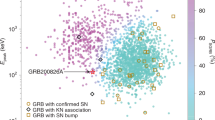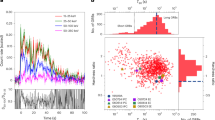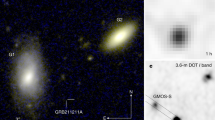Abstract
Over the past five years evidence has mounted that long-duration (>2 s) γ-ray bursts (GRBs)—the most luminous of all astronomical explosions—signal the collapse of massive stars in our Universe. This evidence was originally based on the probable association of one unusual GRB with a supernova1, but now includes the association of GRBs with regions of massive star formation in distant galaxies2,3, the appearance of supernova-like ‘bumps’ in the optical afterglow light curves of several bursts4,5,6 and lines of freshly synthesized elements in the spectra of a few X-ray afterglows7. These observations support, but do not yet conclusively demonstrate, the idea that long-duration GRBs are associated with the deaths of massive stars, presumably arising from core collapse. Here we report evidence that a very energetic supernova (a hypernova) was temporally and spatially coincident with a GRB at redshift z = 0.1685. The timing of the supernova indicates that it exploded within a few days of the GRB, strongly suggesting that core-collapse events can give rise to GRBs, thereby favouring the ‘collapsar’ model8,9.
This is a preview of subscription content, access via your institution
Access options
Subscribe to this journal
Receive 51 print issues and online access
$199.00 per year
only $3.90 per issue
Buy this article
- Purchase on Springer Link
- Instant access to full article PDF
Prices may be subject to local taxes which are calculated during checkout



Similar content being viewed by others
References
Galama, T. J. et al. An unusual supernova in the error box of the γ-ray burst of 25 April 1998. Nature 395, 670–672 (1998)
Paczynski, B. Are gamma-ray bursts in star-forming regions? Astrophys. J. 494, L45–L48 (1998)
Fruchter, A. S. et al. Hubble Space Telescope and Palomar imaging of GRB 990123: Implications for the nature of gamma-ray bursts and their hosts. Astrophys. J. 519, L13–L16 (1999)
Bloom, J. S. et al. The unusual afterglow of the γ-ray burst of 26 March 1998 as evidence for a supernova connection. Nature 401, 453–456 (1999)
Castro-Tirado, A. J. & Gorosabel, J. Optical observations of GRB afterglows: GRB 970508 and GRB 980326 revisited. Astron. Astrophys. Suppl. Ser. 138, 449–450 (1999)
Garnavich, P. et al. Discovery of the low-redshift optical afterglow of GRB 011121 and its progenitor supernova SN 2002ke. Astrophys. J. 582, 924–932 (2003)
Reeves, J. N. et al. The signature of supernova ejecta in the X-ray afterglow of the γ-ray burst 011211. Nature 416, 512–515 (2002)
Woosley, S. E. Gamma-ray bursts from stellar mass accretion disks around black holes. Astrophys. J. 405, 273–277 (1993)
MacFadyen, A. I. & Woosley, S. E. Collapsars: Gamma-ray bursts and explosions in ‘failed supernovae’. Astrophys. J. 524, 262–289 (1999)
Kulkarni, S. R. et al. Radio emission from the unusual supernova 1998bw and its association with the γ-ray burst of 25 April 1998. Nature 395, 663–669 (1998)
Vanderspek, R. et al. GRB030329 (= H2652): A long, extremely bright GRB localized by the HETE WXM and SXC. GCN Circ. 1997 (2003).
Price, P. A. et al. The bright optical afterglow of the nearby γ-ray burst of 29 March 2003. Nature 423, 844–847 (2003)
Torii, K. GRB 030329: OT candidate GCN Circ. 1986 (2003).
Greiner, J. et al. Redshift of GRB 030329. GCN Circ. 2020 (2003).
Patat, F. et al. The metamorphosis of SN 1998bw. Astrophys. J. 555, 900–917 (2001)
Garnavich, P., Matheson, T., Olszewski, E. W., Harding, P. & Stanek, K. Z. GRB 030329 and supernova 2003dh. IAU Circ. 8114 (2003).
Stanek, K. Z. et al. Spectroscopic discovery of the supernova 2003dh associated with GRB 030329. Astrophys. J. Lett. (in the press); preprint at 〈http://arXiv.org/astro-ph/0304173〉 (2003)
Leonard, D. C., Filippenko, A. V., Chornock, R. & Foley, R. J. Photospheric-phase spectropolarimetry and nebular-phase spectroscopy of the peculiar Type Ic supernova 2002ap. Publ. Astron. Soc. Pacif. 114, 1333–1348 (2002)
Iwamoto, K. et al. A hypernova model for the supernova associated with the γ-ray burst of 25 April 1998. Nature 395, 672–674 (1998)
Woosley, S. E., Eastman, R. G. & Schmidt, B. P. Gamma-ray bursts and Type Ic supernova SN 1998bw. Astrophys. J. 516, 788–796 (1999)
Sollerman, J. et al. SN 1998bw at late phases. Astrophys. J. 537, L127–L130 (2000)
Granot, J., Panaitescu, A., Kumar, P. & Woosley, S. E. Off-axis afterglow emission from jetted gamma-ray bursts. Astrophys. J. 570, L61–L64 (2002)
Vietri, M. & Stella, L. Supranova events from spun-up neutron stars: an explosion in search of an observation. Astrophys. J. 527, L43–L46 (1999)
Wheeler, J., Yi, I., Höflich, P. & Wang, L. Asymmetric supernovae, pulsars, magnetars, and gamma-ray bursts. Astrophys. J. 537, 810–823 (2000)
Zharikov, S., Benitez, E., Torrealba, J. & Stepanian, J. GRB030329, SPM optical observations. GCN Circ. 2022 (2003).
Schlegel, D. J., Finkbeiner, D. P. & Davis, M. Maps of dust infrared emission for use in estimation of reddening and cosmic microwave background radiation foregrounds. Astrophys. J. 500, 525–553 (1998)
Kennicutt, R. C. Star formation in galaxies along the Hubble sequence. Annu. Rev. Astron. Astrophys. 36, 189–232 (1998)
Lee, H., Grebel, E. K. & Hodge, P. W. Nebular abundances of nearby southern dwarf galaxies. Astron. Astrophys. 401, 141–159 (2003)
Blake, C. & Bloom, J. S. GRB 030329: Optical pre-imaging. GCN Circ. 2011 (2003).
Fynbo, J. U. et al. Hubble Space Telescope Space Telescope Imaging Spectrograph imaging of the host galaxy of GRB 980425/SN 1998bw. Astrophys. J. 542, L89–L93 (2000)
Acknowledgements
We thank F. Patat for discussions. This paper is based on observations collected by the Gamma-Ray Burst Collaboration at ESO (GRACE) at the European Southern Observatory, Paranal, Chile. We thank the ESO staff at the Paranal Observatory, in particular N. Ageorges, P. Gandhi, S. Hubrig, R. Johnson, C. Ledoux, K. O'Brien, R. Scarpa, T. Szeifert and L. Vanzi, for their help in securing the service mode data reported here. We acknowledge benefits from collaboration within the EU FP5 Research Training Network “Gamma-Ray Bursts: An Enigma and a Tool”. This work was also supported by the Danish Natural Science Research Council (SNF). J.P.U.F. and K.P. acknowledge support from the Carlsberg Foundation.
Author information
Authors and Affiliations
Corresponding author
Ethics declarations
Competing interests
The authors declare that they have no competing financial interests.
Rights and permissions
About this article
Cite this article
Hjorth, J., Sollerman, J., Møller, P. et al. A very energetic supernova associated with the γ-ray burst of 29 March 2003. Nature 423, 847–850 (2003). https://doi.org/10.1038/nature01750
Received:
Accepted:
Published:
Issue Date:
DOI: https://doi.org/10.1038/nature01750
This article is cited by
-
A long-duration gamma-ray burst with a peculiar origin
Nature (2022)
-
A wind environment and Lorentz factors of tens explain gamma-ray bursts X-ray plateau
Nature Communications (2022)
-
A novel trigger algorithm for wide-field-of-view imaging atmospheric Cherenkov technique experiments
Nuclear Science and Techniques (2022)
-
Photometric studies on the host galaxies of gamma-ray bursts using 3.6m Devasthal optical telescope
Journal of Astrophysics and Astronomy (2022)
-
A possible bright ultraviolet flash from a galaxy at redshift z ≈ 11
Nature Astronomy (2020)
Comments
By submitting a comment you agree to abide by our Terms and Community Guidelines. If you find something abusive or that does not comply with our terms or guidelines please flag it as inappropriate.



